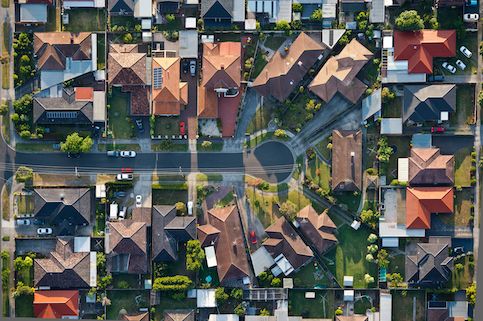Conforming conventional loans are the most popular type of mortgage in the U.S. Conforming mortgages are private loans that meet specific requirements that allow lenders to sell them to Fannie Mae and Freddie Mac, which are government-sponsored enterprises. If you’re planning to buy a home, it’s important to understand how conforming loans work.
Key Takeaways:
- Conforming loans are conventional mortgages with maximum loan amounts and specific borrower requirements.
- Lenders can sell conforming loans to government-sponsored enterprises, reducing their risk and freeing up cash to make more loans.
- Conforming loans typically cost less than government-backed loans, though they also have stricter eligibility requirements.
How Conforming Loans Work
A conforming loan is a conventional mortgage that meets requirements set by the government to encourage lenders to offer more loans to more borrowers. Lenders can sell conforming loans to Fannie Mae or Freddie Mac, which reduces their risk and helps them provide more loans
While the Federal Housing Finance Agency sets the requirements, the government does not insure or guarantee the loans.
Conforming loans may have fixed or adjustable interest rates, with 30- or 15-year terms.
What Is The FHFA?
The Federal Housing Finance Agency is an independent government agency that regulates Fannie Mae and Freddie Mac and sets conforming loan limits. The FHFA was created in 2008 to keep the housing market stable and liquid after the financial crisis.
What Are Fannie Mae and Freddie Mac?
The government created Fannie Mae and Freddie Mac to buy loans from lenders and encourage a stable and affordable housing market. Buying conforming loans reduces the lender’s risk and provides them with cash they can use to make additional loans. Fannie and Freddie package the loans they buy into mortgage-backed securities sold and traded on secondary markets.
What’s Your Goal?
Buy A Home
Discover mortgage options that fit your unique financial needs.

Refinance
Refinance your mortgage to have more money for what matters.
Tap Into Equity
Use your home’s equity and unlock cash to achieve your goals.
Conforming Loan Requirements
Let’s look at the eligibility requirements for a conforming loan. Keep in mind that lenders can set additional requirements.
Maximum Loan Amount
The FHFA sets each year maximum loan limits for conforming loans. These limits vary by location and the number of units in the home you’re buying.
The baseline limit applies in most of the country, with a higher limit established for specific areas where home prices are higher. The FHFA posts an online tool for finding out where the high-cost limit applies.
2025 Conforming Loan Limits
| Number Of Units | Baseline Loan Limit | High-Cost Area Loan Limit |
|---|---|---|
| 1 | $806,500 | $1,209,750 |
| 2 | $1,032,650 | $1,548,975 |
| 3 | $1,248,150 | $1,872,225 |
| 4 | $1,551,250 | $2,326,875 |
Minimum Down Payment
Fannie Mae requires a down payment of at least 3% when buying a one-unit home with a fixed-rate mortgage. Buying a one-unit home with an ARM or a two- to four-unit home with any loan type requires 5% down.
Freddie Mac requires 5% down on a one-unit home, 15% on two units, and 20% on three- and four-unit homes.
Private Mortgage Insurance
If you make a down payment of less than 20% of the purchase price, you must pay for private mortgage insurance. PMI protects the lender if you stop making mortgage payments. It does not protect the borrower. Your lender will arrange your PMI coverage with a private insurance company, and you’ll pay for it as part of your monthly mortgage payment.
Minimum Credit Score
You must have a credit score of at least 620 to be eligible for a conforming loan, though lenders may require a higher score.
Maximum DTI Ratio
Your debt-to-income ratio measures how much of your monthly income is required to pay your debts. Calculate your DTI ratio by adding up your monthly debt payments, dividing by your gross monthly income and multiplying by 100. Most lenders require that your DTI not exceed 50%, though some lenders have stricter limits as low as 36%.
Closing Costs
Closing costs include all the fees required to fund your mortgage and transfer legal ownership of the home. Closing costs usually include fees for the home appraisal, inspection, title search and title insurance. You can expect closing costs to total 2% to 5% of the purchase price.
Additional Guidelines
Additional guidelines for conforming loans include:
- It has to be a single-family home. While some people may think of a single-family home as a home where only one family lives, the FHFA has a different definition. It defines a single-family home as any home with one to four units.
- Disclosures: Certain disclosures applying to all mortgage loans, including conforming loans, will be made to borrowers as they proceed through the mortgage application process. Sometimes referred to as the Truth in Lending Act and Real Estate Settlement Procedures Act of 1974.
Ready To Become A Homeowner?
Get matched with a lender that can help you find the right mortgage.
Conforming Loans Vs. Non-Conforming Loans
A loan that doesn’t meet the criteria to be purchased by Fannie Mae or Freddie Mac is a non-conforming loan. Lenders are free to set their own criteria for non-conforming loans.
The most common type of non-conforming loan is a jumbo loan, which exceeds the conforming loan limit.
Other non-conforming loans are geared toward borrowers who don’t meet conforming loan standards. In many cases, self-employed or seasonal workers have a hard time verifying their income adequately and must rely on a non-conforming loan to purchase a home.
Government-Backed Loans
The U.S. government offers loan programs to help specific types of buyers afford a home. The most common government-backed loans are:
- Federal Housing Administration loans. FHA loans have a lower credit score requirement. You can buy a home with a credit score of 500 with a down payment of 10%, or a score of 580 with 3.5% down. You’ll also need to pay mortgage insurance premiums.
- Veterans Affairs loans. VA loans are available only to eligible military service members, veterans and their surviving spouses. They do not require a down payment or mortgage insurance, but you must pay an upfront funding fee.
- U.S. Department of Agriculture loans. USDA loans are for low- and moderate-income borrowers buying homes in specific rural areas. You do not need a down payment but you must pay an upfront fee and purchase mortgage insurance.
Take The First Step To Buying A Home
Find a lender that will work with your unique financial situation.
Conforming Loan Examples
Let’s say you want to buy a one-unit home in Wayne County, Michigan, for $250,000 with a $50,000 down payment and a conventional loan for $200,000. Because your loan is well under the baseline limit of $766,550, your mortgage will be considered a conforming loan.
On the other hand, if you want to buy a single-family home in San Francisco for $1.1 million, it’s still a conforming loan because the high-cost area limit is $1,209,750. A 20% down payment would equal $220,000, meaning you’d need a $880,000 loan. However, with a conforming loan, you can make a 3% down payment, which would be $33,000.
Pros And Cons Of Conforming Loans
Here’s a rundown of the main benefits and drawbacks of conforming loans.
Pros And Cons Of Conforming Loans
| Pros | Cons |
|---|---|
| Most common type of loan. | There are limits to how much you can borrow. |
| Lower interest rates than non-conforming loans. | Stricter requirements than government-backed loans. |
| Easier eligibility requirements than jumbo loans. | PMI is required if your down payment is less than 20%. |
| Come with guidelines that protect borrowers from predatory lending. | |
| You can cancel PMI once you reach 20% equity. | |
| Can be used to buy a second home or rental property. |
FAQ
Here are answers to common questions about conforming loans.
What does it mean if a loan is conforming?
Conforming loans meet federal guidelines that allow lenders to sell the loan to Fannie Mae or Freddie Mac. Conforming loans limit how much you can borrow based on where you’re buying your home and have specific borrower requirements for credit scores, minimum down payment and maximum DTI ratio.
What are the conforming loan limits for 2025?
The 2025 conforming loan limit for a one-unit single-family home is $806,500. This amount can be different depending on the housing market in the area where you live. In higher-cost areas, the limit is $1,209,750.
What’s the difference between a conforming loan and a conventional loan?
A conforming loan is a type of conventional loan, which is a mortgage offered by a private lender that is not backed by a government agency.
The Bottom Line
If you meet the eligibility requirements for a conforming loan, it might be the right mortgage option. Conforming loans are popular with buyers who want to avoid some of the limitations associated with government-backed loans, which are designed for and mostly limited to specific types of buyers. Conforming loans can also be an attractive option to borrowers who simply don’t need or qualify for a jumbo loan.
More From Quicken Loans:
Hanna Kielar contributed to the writing of this article.

Rory Arnold
Rory Arnold is a Los Angeles-based writer who has contributed to a variety of publications, including Quicken Loans, LowerMyBills, Ranker, Earth.com and JerseyDigs. He has also been quoted in The Atlantic. Rory received his Bachelor of Science in Media, Culture and Communication from New York University. He also completed the SoFi/Coursera Fundamentals of Personal Finance Specialization consisting of five courses: Introduction to Personal Finance, Saving Money for the Future, Managing Debt, Fundamentals of Investing, and Risk Management in Personal Finance.












